Abstract
OBJECTIVE: To study the effect of transdermal scopolamine on heart rate variability, baroreflex sensitivity, and exercise performance in patients with heart failure and age matched healthy volunteers. DESIGN: Double blind, randomised, placebo controlled, crossover study. PATIENTS: 16 patients with chronic, stable heart failure due to ischaemic cardiomyopathy (mean (SEM) age 58 (2) years; mean (SEM) radionuclide left ventricular ejection fraction 28 (2)%; New York Heart Association class II-III) and eight age matched healthy controls. INTERVENTION: Transdermal scopolamine (500 micrograms delivered over 72 h) or a placebo patch was administered for 48 h. MAIN OUTCOME MEASURES: Indices of tonic and reflex cardiac vagal activity and exercise performance. RESULTS: In both groups scopolamine produced a reduction in the 24 h average heart rate and an increase in the time domain measures of heart rate variability. Both the incidence and severity of ventricular arrhythmias remained unchanged. Baroreflex sensitivity, evaluated by the phenylephrine technique, increased significantly (P < 0.001) with scopolamine in patients with heart failure (6.22 (2.81) ms/mm Hg) and in healthy volunteers (5.97 (2.20) ms/mm Hg) as did the amplitude of respiratory sinus arrhythmia, computed by autoregressive spectral analysis of 10 min electrocardiographic recordings (319.9 (123.5) and 657.3 (126.6) ms2 respectively, P < 0.001). While exercise performance did not change, heart rate at submaximal exercise was significantly reduced by scopolamine in each group. CONCLUSIONS: In patients with mild to moderate heart failure low doses of scopolamine increased tonic and reflex cardiac vagal activity. This was achieved without affecting exercise tolerance or the incidence and severity of ventricular arrhythmias.
Full text
PDF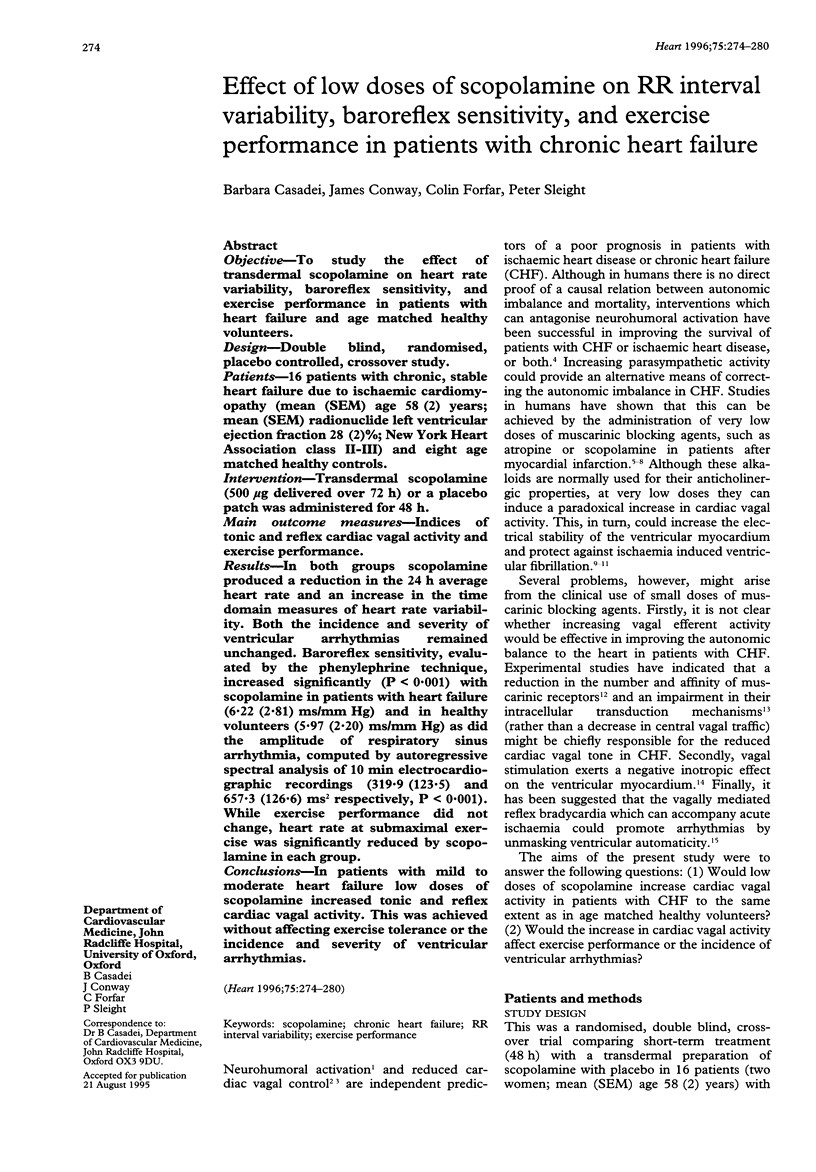
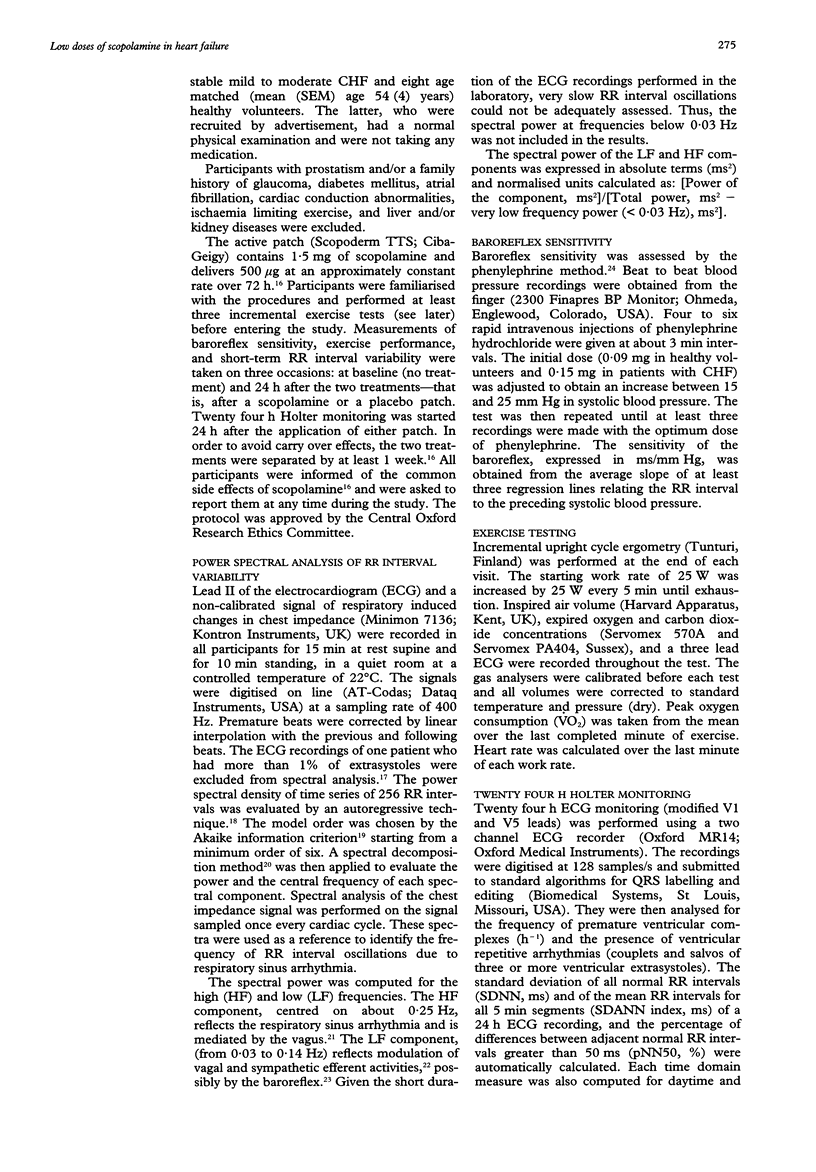
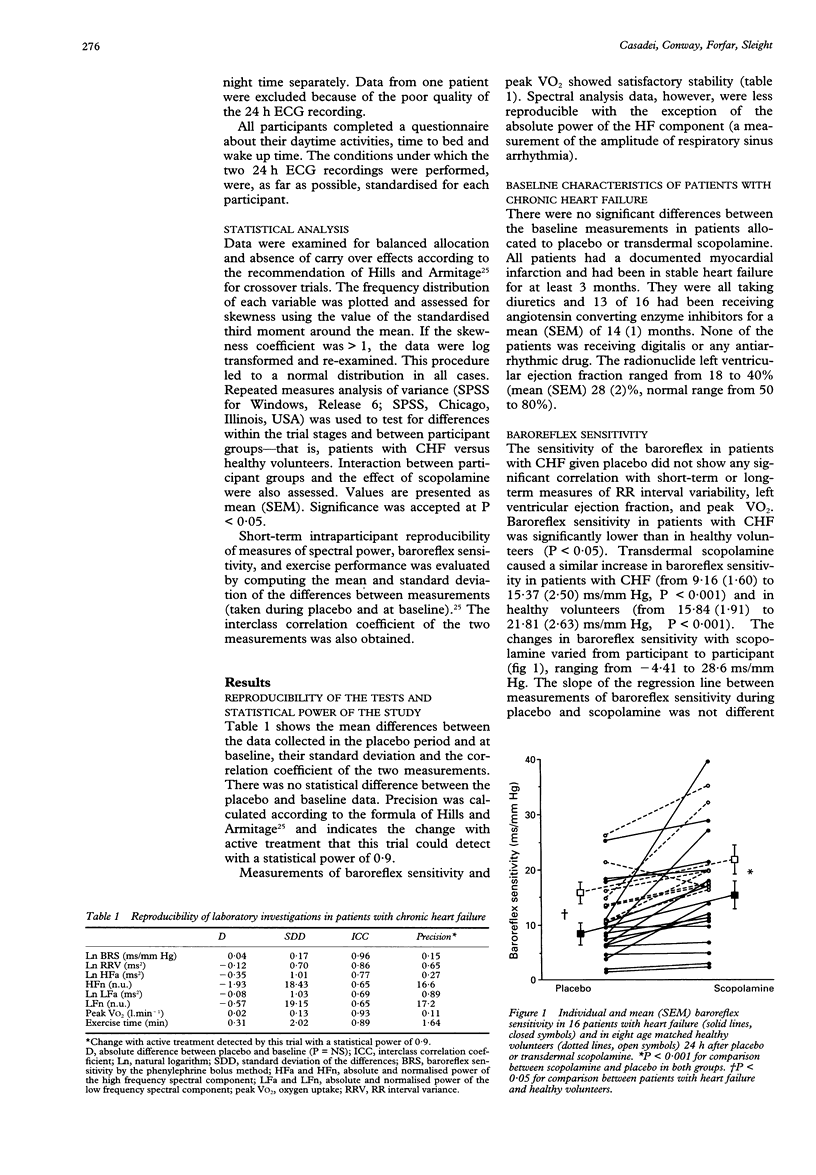
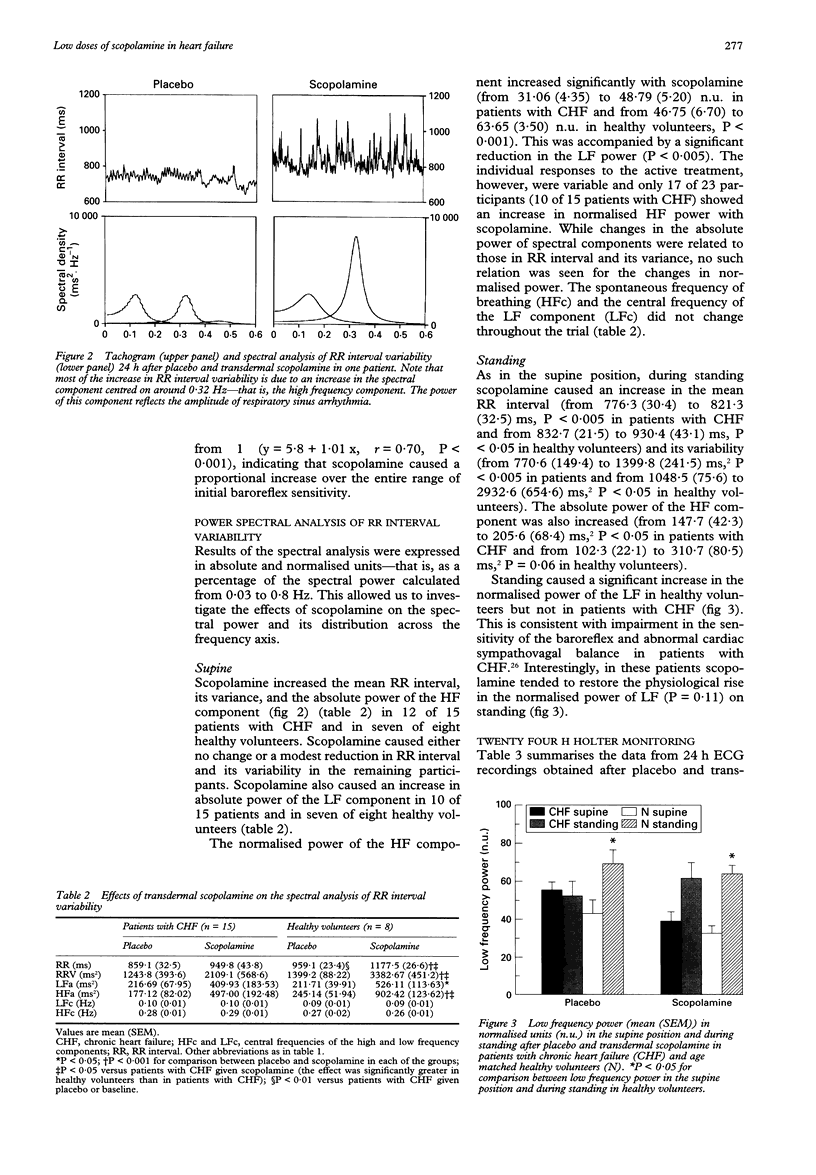

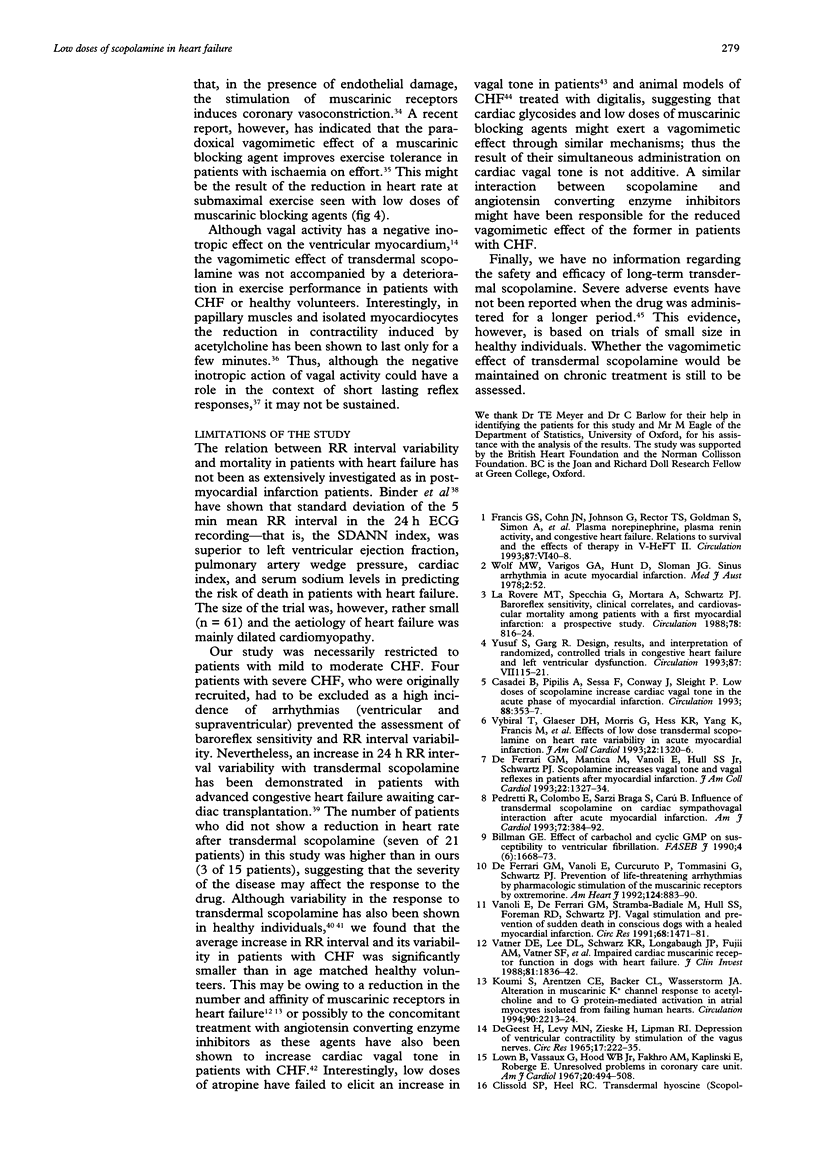
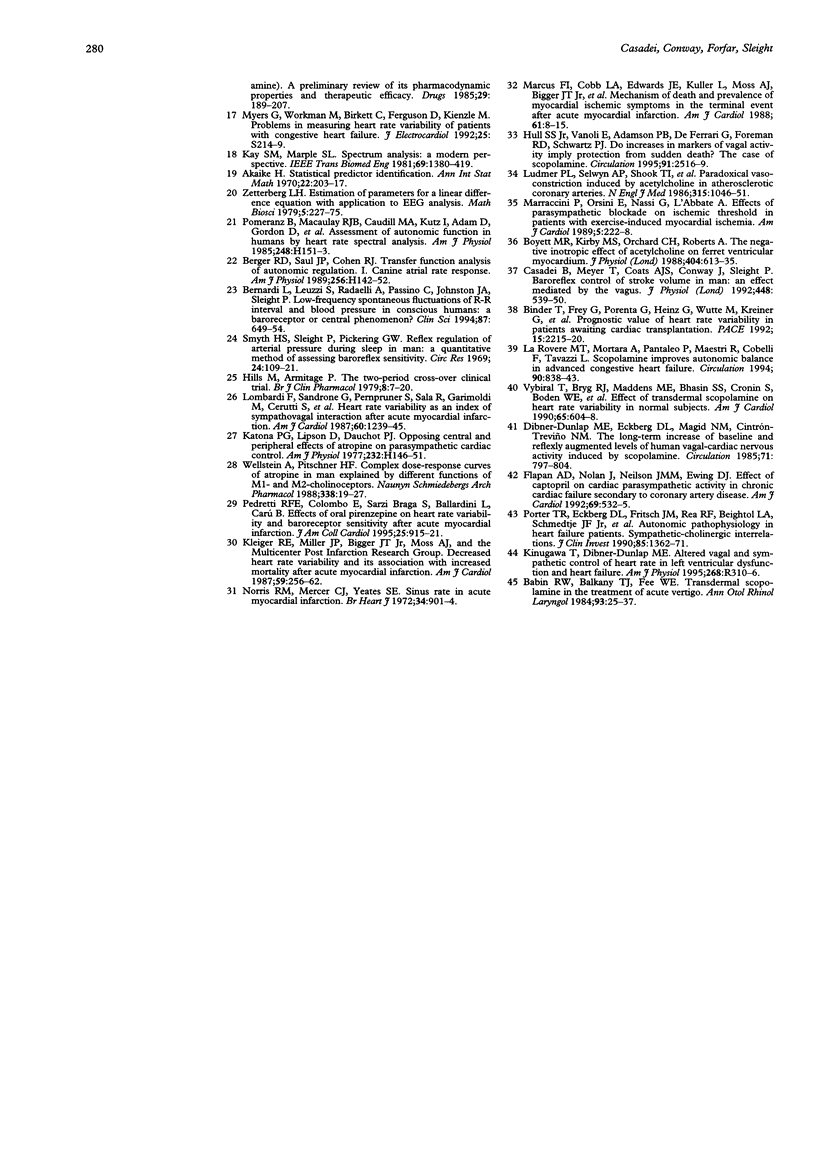
Selected References
These references are in PubMed. This may not be the complete list of references from this article.
- Babin R. W., Balkany T. J., Fee W. E. Transdermal scopolamine in the treatment of acute vertigo. Ann Otol Rhinol Laryngol. 1984 Jan-Feb;93(1 Pt 1):25–27. doi: 10.1177/000348948409300106. [DOI] [PubMed] [Google Scholar]
- Bernardi L., Leuzzi S., Radaelli A., Passino C., Johnston J. A., Sleight P. Low-frequency spontaneous fluctuations of R-R interval and blood pressure in conscious humans: a baroreceptor or central phenomenon? Clin Sci (Lond) 1994 Dec;87(6):649–654. doi: 10.1042/cs0870649. [DOI] [PubMed] [Google Scholar]
- Billman G. E. Effect of carbachol and cyclic GMP on susceptibility to ventricular fibrillation. FASEB J. 1990 Apr 1;4(6):1668–1673. doi: 10.1096/fasebj.4.6.2156744. [DOI] [PubMed] [Google Scholar]
- Binder T., Frey B., Porenta G., Heinz G., Wutte M., Kreiner G., Gössinger H., Schmidinger H., Pacher R., Weber H. Prognostic value of heart rate variability in patients awaiting cardiac transplantation. Pacing Clin Electrophysiol. 1992 Nov;15(11 Pt 2):2215–2220. doi: 10.1111/j.1540-8159.1992.tb03050.x. [DOI] [PubMed] [Google Scholar]
- Boyett M. R., Kirby M. S., Orchard C. H., Roberts A. The negative inotropic effect of acetylcholine on ferret ventricular myocardium. J Physiol. 1988 Oct;404:613–635. doi: 10.1113/jphysiol.1988.sp017309. [DOI] [PMC free article] [PubMed] [Google Scholar]
- Casadei B., Meyer T. E., Coats A. J., Conway J., Sleight P. Baroreflex control of stroke volume in man: an effect mediated by the vagus. J Physiol. 1992 Mar;448:539–550. doi: 10.1113/jphysiol.1992.sp019056. [DOI] [PMC free article] [PubMed] [Google Scholar]
- Casadei B., Pipilis A., Sessa F., Conway J., Sleight P. Low doses of scopolamine increase cardiac vagal tone in the acute phase of myocardial infarction. Circulation. 1993 Aug;88(2):353–357. doi: 10.1161/01.cir.88.2.353. [DOI] [PubMed] [Google Scholar]
- Clissold S. P., Heel R. C. Transdermal hyoscine (Scopolamine). A preliminary review of its pharmacodynamic properties and therapeutic efficacy. Drugs. 1985 Mar;29(3):189–207. doi: 10.2165/00003495-198529030-00001. [DOI] [PubMed] [Google Scholar]
- DEGEEST H., LEVY M. N., ZIESKE H., LIPMAN R. I. DEPRESSION OF VENTRICULAR CONTRACTILITY BY STIMULATION OF THE VAGUS NERVES. Circ Res. 1965 Sep;17:222–235. doi: 10.1161/01.res.17.3.222. [DOI] [PubMed] [Google Scholar]
- De Ferrari G. M., Mantica M., Vanoli E., Hull S. S., Jr, Schwartz P. J. Scopolamine increases vagal tone and vagal reflexes in patients after myocardial infarction. J Am Coll Cardiol. 1993 Nov 1;22(5):1327–1334. doi: 10.1016/0735-1097(93)90538-c. [DOI] [PubMed] [Google Scholar]
- De Ferrari G. M., Vanoli E., Curcuruto P., Tommasini G., Schwartz P. J. Prevention of life-threatening arrhythmias by pharmacologic stimulation of the muscarinic receptors with oxotremorine. Am Heart J. 1992 Oct;124(4):883–890. doi: 10.1016/0002-8703(92)90968-2. [DOI] [PubMed] [Google Scholar]
- Dibner-Dunlap M. E., Eckberg D. L., Magid N. M., Cintrón-Treviño N. M. The long-term increase of baseline and reflexly augmented levels of human vagal-cardiac nervous activity induced by scopolamine. Circulation. 1985 Apr;71(4):797–804. doi: 10.1161/01.cir.71.4.797. [DOI] [PubMed] [Google Scholar]
- Flapan A. D., Nolan J., Neilson J. M., Ewing D. J. Effect of captopril on cardiac parasympathetic activity in chronic cardiac failure secondary to coronary artery disease. Am J Cardiol. 1992 Feb 15;69(5):532–535. doi: 10.1016/0002-9149(92)90999-f. [DOI] [PubMed] [Google Scholar]
- Hills M., Armitage P. The two-period cross-over clinical trial. Br J Clin Pharmacol. 1979 Jul;8(1):7–20. doi: 10.1111/j.1365-2125.1979.tb05903.x. [DOI] [PMC free article] [PubMed] [Google Scholar]
- Hull S. S., Jr, Vanoli E., Adamson P. B., De Ferrari G. M., Foreman R. D., Schwartz P. J. Do increases in markers of vagal activity imply protection from sudden death? The case of scopolamine. Circulation. 1995 May 15;91(10):2516–2519. doi: 10.1161/01.cir.91.10.2516. [DOI] [PubMed] [Google Scholar]
- Kleiger R. E., Miller J. P., Bigger J. T., Jr, Moss A. J. Decreased heart rate variability and its association with increased mortality after acute myocardial infarction. Am J Cardiol. 1987 Feb 1;59(4):256–262. doi: 10.1016/0002-9149(87)90795-8. [DOI] [PubMed] [Google Scholar]
- La Rovere M. T., Mortara A., Pantaleo P., Maestri R., Cobelli F., Tavazzi L. Scopolamine improves autonomic balance in advanced congestive heart failure. Circulation. 1994 Aug;90(2):838–843. doi: 10.1161/01.cir.90.2.838. [DOI] [PubMed] [Google Scholar]
- La Rovere M. T., Specchia G., Mortara A., Schwartz P. J. Baroreflex sensitivity, clinical correlates, and cardiovascular mortality among patients with a first myocardial infarction. A prospective study. Circulation. 1988 Oct;78(4):816–824. doi: 10.1161/01.cir.78.4.816. [DOI] [PubMed] [Google Scholar]
- Lombardi F., Sandrone G., Pernpruner S., Sala R., Garimoldi M., Cerutti S., Baselli G., Pagani M., Malliani A. Heart rate variability as an index of sympathovagal interaction after acute myocardial infarction. Am J Cardiol. 1987 Dec 1;60(16):1239–1245. doi: 10.1016/0002-9149(87)90601-1. [DOI] [PubMed] [Google Scholar]
- Lown B., Vasaux C., Hood W. B., Jr, Fakhro A. M., Kaplinsky E., Roberge G. Unresolved problems in coronary care. Am J Cardiol. 1967 Oct;20(4):494–508. doi: 10.1016/0002-9149(67)90027-6. [DOI] [PubMed] [Google Scholar]
- Lown B., Vasaux C., Hood W. B., Jr, Fakhro A. M., Kaplinsky E., Roberge G. Unresolved problems in coronary care. Am J Cardiol. 1967 Oct;20(4):494–508. doi: 10.1016/0002-9149(67)90027-6. [DOI] [PubMed] [Google Scholar]
- Ludmer P. L., Selwyn A. P., Shook T. L., Wayne R. R., Mudge G. H., Alexander R. W., Ganz P. Paradoxical vasoconstriction induced by acetylcholine in atherosclerotic coronary arteries. N Engl J Med. 1986 Oct 23;315(17):1046–1051. doi: 10.1056/NEJM198610233151702. [DOI] [PubMed] [Google Scholar]
- Marcus F. I., Cobb L. A., Edwards J. E., Kuller L., Moss A. J., Bigger J. T., Jr, Fleiss J. L., Rolnitzky L., Serokman R. Mechanism of death and prevalence of myocardial ischemic symptoms in the terminal event after acute myocardial infarction. Am J Cardiol. 1988 Jan 1;61(1):8–15. doi: 10.1016/0002-9149(88)91295-7. [DOI] [PubMed] [Google Scholar]
- Norris R. M., Mercer C. J., Yeates S. E. Sinus rate in acute myocardial infarction. Br Heart J. 1972 Sep;34(9):901–904. doi: 10.1136/hrt.34.9.901. [DOI] [PMC free article] [PubMed] [Google Scholar]
- Pedretti R. F., Colombo E., Sarzi Braga S., Ballardini L., Carù B. Effects of oral pirenzepine on heart rate variability and baroreceptor reflex sensitivity after acute myocardial infarction. J Am Coll Cardiol. 1995 Mar 15;25(4):915–921. doi: 10.1016/0735-1097(94)00468-6. [DOI] [PubMed] [Google Scholar]
- Pedretti R., Colombo E., Sarzi Braga S., Carù B. Influence of transdermal scopolamine on cardiac sympathovagal interaction after acute myocardial infarction. Am J Cardiol. 1993 Aug 15;72(5):384–392. doi: 10.1016/0002-9149(93)91127-4. [DOI] [PubMed] [Google Scholar]
- Pomeranz B., Macaulay R. J., Caudill M. A., Kutz I., Adam D., Gordon D., Kilborn K. M., Barger A. C., Shannon D. C., Cohen R. J. Assessment of autonomic function in humans by heart rate spectral analysis. Am J Physiol. 1985 Jan;248(1 Pt 2):H151–H153. doi: 10.1152/ajpheart.1985.248.1.H151. [DOI] [PubMed] [Google Scholar]
- Porter T. R., Eckberg D. L., Fritsch J. M., Rea R. F., Beightol L. A., Schmedtje J. F., Jr, Mohanty P. K. Autonomic pathophysiology in heart failure patients. Sympathetic-cholinergic interrelations. J Clin Invest. 1990 May;85(5):1362–1371. doi: 10.1172/JCI114580. [DOI] [PMC free article] [PubMed] [Google Scholar]
- Smyth H. S., Sleight P., Pickering G. W. Reflex regulation of arterial pressure during sleep in man. A quantitative method of assessing baroreflex sensitivity. Circ Res. 1969 Jan;24(1):109–121. doi: 10.1161/01.res.24.1.109. [DOI] [PubMed] [Google Scholar]
- Vanoli E., De Ferrari G. M., Stramba-Badiale M., Hull S. S., Jr, Foreman R. D., Schwartz P. J. Vagal stimulation and prevention of sudden death in conscious dogs with a healed myocardial infarction. Circ Res. 1991 May;68(5):1471–1481. doi: 10.1161/01.res.68.5.1471. [DOI] [PubMed] [Google Scholar]
- Vatner D. E., Lee D. L., Schwarz K. R., Longabaugh J. P., Fujii A. M., Vatner S. F., Homcy C. J. Impaired cardiac muscarinic receptor function in dogs with heart failure. J Clin Invest. 1988 Jun;81(6):1836–1842. doi: 10.1172/JCI113528. [DOI] [PMC free article] [PubMed] [Google Scholar]
- Vybiral T., Bryg R. J., Maddens M. E., Bhasin S. S., Cronin S., Boden W. E., Lehmann M. H. Effects of transdermal scopolamine on heart rate variability in normal subjects. Am J Cardiol. 1990 Mar 1;65(9):604–608. doi: 10.1016/0002-9149(90)91038-8. [DOI] [PubMed] [Google Scholar]
- Vybiral T., Glaeser D. H., Morris G., Hess K. R., Yang K., Francis M., Pratt C. M. Effects of low dose transdermal scopolamine on heart rate variability in acute myocardial infarction. J Am Coll Cardiol. 1993 Nov 1;22(5):1320–1326. doi: 10.1016/0735-1097(93)90537-b. [DOI] [PubMed] [Google Scholar]
- Wellstein A., Pitschner H. F. Complex dose-response curves of atropine in man explained by different functions of M1- and M2-cholinoceptors. Naunyn Schmiedebergs Arch Pharmacol. 1988 Jul;338(1):19–27. doi: 10.1007/BF00168807. [DOI] [PubMed] [Google Scholar]


